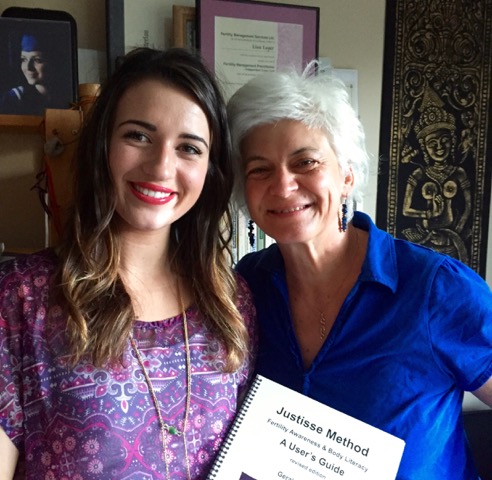Adapted from A Baby Born to Body Literacy, Femme Fertile, Winter, 2006, p. 6
My daughter was born at home with midwives. Not because I was brave, but because I was chicken. Working in health care, I had heard too many maternity-ward horror stories. My studies in fertility awareness and charting my own cycles gave me confidence in my own body to do what it was supposed to do. I also trusted my baby to do her part, and felt safe with my husband and midwives by my side. She came straight to my breast and grew up nursing on demand without ear infections, fevers, constipation, or sniffles.
Her dad and I taught her how to live by explaining everything, how food was fuel, why we wash our hands and wipe our bums. We modelled a casual intimacy in the bathroom; she saw my mucus and menstrual blood. As a toddler she loved pulling the strip off my disposable pads; as a tween she wanted more privacy. The early rituals of puberty were all dealt with straightforwardly and I was full of information and eager to go into detail so my daughter was well-informed about sex and fertility compared to her peers.
When my daughter’s first period arrived shortly after her 12th birthday, the first thing I did was get a blank menstrual cycle chart and have her fill in the date of her first Day One. Since then, I have been revealing more details about the adult world, welcoming her into the “blood mysteries” with stories both mythical and personal. She learned about the back stories related to puberty and sexuality for Little Red Riding Hood, that cherries represent virginity. We watched the 1976 movie Carrie, and she was appalled that Carrie’s mother didn’t tell her daughter anything about what to expect before her periods began.
At first I helped my daughter chart her cycles, complete with mucus observations, abdominal pains, cramps and clots. I remember charting during story time as part of our evening routine. She reported sensations and mucus observations, but her main interest was in knowing when to expect her periods in relation to swimming trips or sleep-overs.
When she decided to have sex at 17, my daughter went to the public health unit and got some birth control pills from the nurse. This was probably thanks to the sex education she got in high school as much as from the human tendency to reject whatever one’s mom does. I kept my mouth shut with difficulty until side effects appeared. She then tried the Nuvaring, unsuccessfully, and eventually settled on condoms as her birth control method. This process was more difficult for me than for her, because I had to watch as she developed gall bladder symptoms, nausea, and mood swings that interfered with her relationships until she arrived at her own decision to ditch the synthetic hormones.
My daughter has a good foundation of body literacy: she trusts that her body functions are normal, she understands charting, and she is grounded by this knowledge as a young woman of 22 years old. My colleagues will point out that few girls have the good fortune to grow up with a fertility awareness educator for a mother, but I am optimistic that every girl can learn to be aware of her fertility cycles and benefit from even a rudimentary understanding of ovulation. This is why I implored sexual health educators in another blog post–Sex Ed. for Teens: Where’s The Mucus?–to explain the role of cervical mucus in identifying the fertile time.
Research evidence suggests that fertility awareness education leads to delayed sexual activity, reduced teen pregnancy, and lower risky behaviour. I have observed this in my daughter’s life; she has been discerning in her relationships, aware of her worth, and careful with her health. I expect that the body literacy she acquired as a child and teen will serve her well in all reproductive health events throughout her life.
Lisa Leger, B.A., is a Holistic Reproductive Health Practitioner on Vancouver Island. She teaches the Justisse Method of fertility awareness in a pharmacy setting where she works as the Natural Health Consultant.



{{applause}}
If I ever have a daughter I hope to do the same. How heart wrenching it must have been when she went on hormones. Kudos to you for letting her figure it all out.
I’ve been slowly learning about my body. As a young girl growing up in Texas, my mother introduced me to Midol and tampons, but little else. I certainly don’t blame her, instead, I have a great appreciation and desire to share my knowledge. I switched to the cup during my last cycle, and I love it. This year, I finally went off hormonal BC pills and I am learning about non-hormonal options. Thanks so much for all that you have done to guide your daughter through her life. P.S. I’m also 22!
As a fertility awareness educator with a 10 year old daughter, I have wondered how I will react if my daughter ever wants to use hormonal bc. Thank you so much Lisa for sharing your story.
thanks for commenting Valerie. It means a lot to know that young women are reading these blogs. It’s sometimes a challenge to find women of any age who get me.
Yes – it was a horrifying experience. I called my mentor/colleague, founder of Justisse Geraldine Matus for advice on how to handle it.
Thank you for sharing. I’ve often wondered what it would be like to have a mother like you. My mom didn’t like to talk to me about menstruation or sex. She discouraged me from using tampons, and tried to teach me that women should not have sex until they were married. Luckily my friends provided me with helpful information, and eventually I had lots of wonderful women in my life. I was thrilled to finally be introduced to FAM, and it has changed my life in many ways.